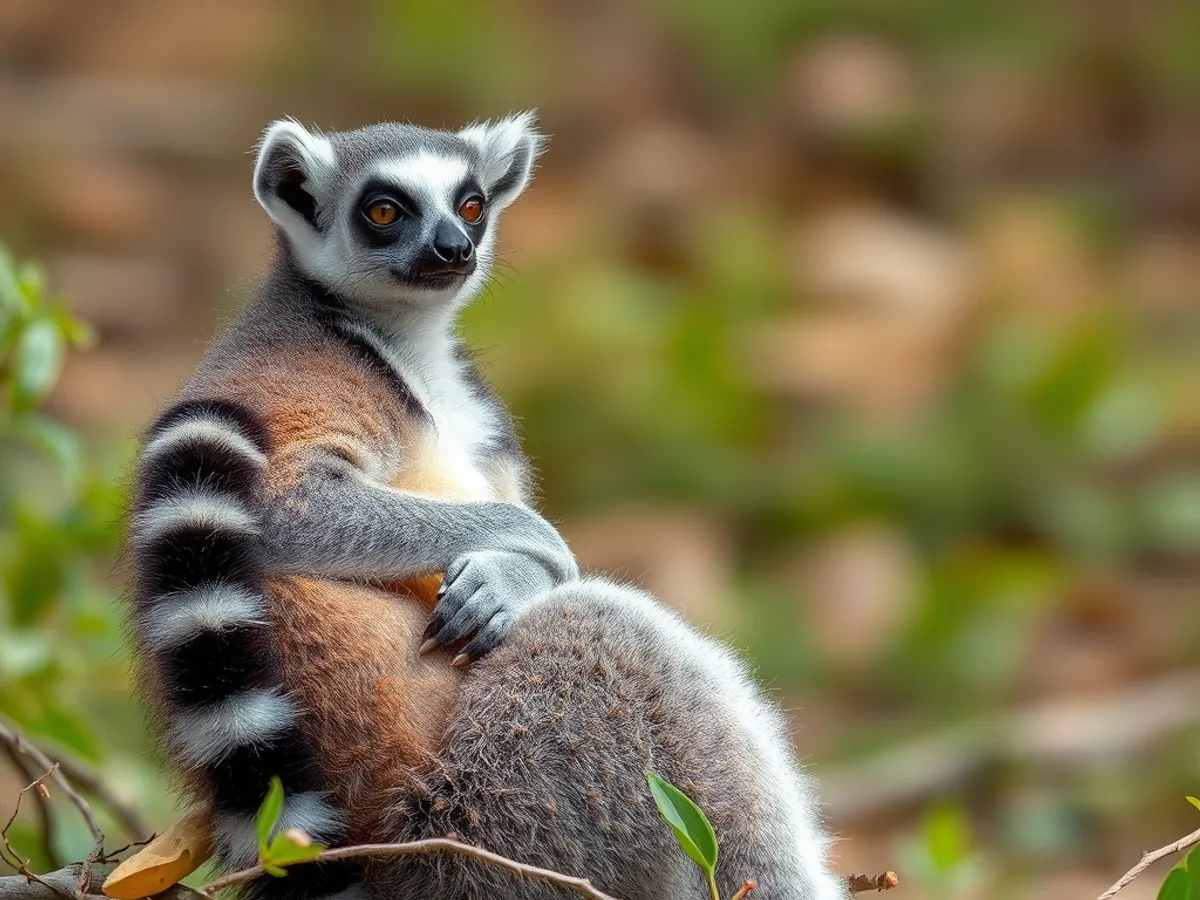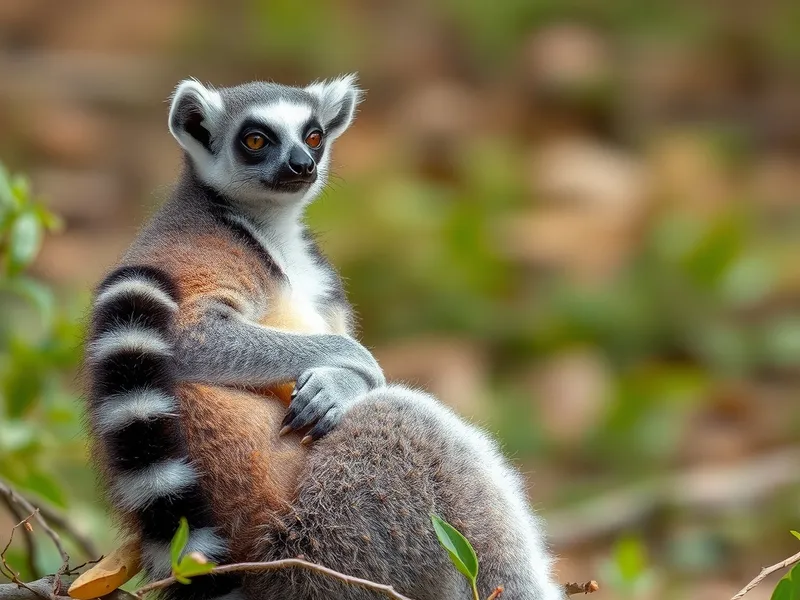
Ring-tailed Lemur
Lemur catta

Meet the Ring-tailed Lemur
The ring-tailed lemur is a distinctive primate native to the island of Madagascar, easily recognized by its long, bushy tail with alternating black and white rings. These highly social animals live in groups called troops, often led by a dominant female. They spend much of their time on the ground, unlike many other lemurs, and are known for their sunbathing behavior, sitting upright with outstretched arms. Ring-tailed lemurs are vital for seed dispersal in their ecosystem and are a flagship species for Madagascar's unique wildlife.
Classification
Mammal
Habitat
Dry forests and scrublands
Diet
Omnivore
Lifespan
16-19 years in the wild
Conservation
Endangered
Weight
2.2-3.5 kg
📖Fascinating Facts
Sun Worshippers
Ring-tailed lemurs are famous for sunbathing in a yoga-like pose, sitting upright with arms outstretched to warm themselves in the morning.
Strong Social Bonds
They live in matriarchal groups of up to 30 individuals, where females are dominant over males—a rare trait among primates.
Ground Dwellers
Unlike most lemurs, ring-tailed lemurs spend up to 40% of their time on the ground rather than in trees.
📋Detailed Description
The ring-tailed lemur (Lemur catta) is a medium-sized primate, typically weighing between 2.2 and 3.5 kg (4.9–7.7 lbs), with a body length of 39–46 cm (15–18 in) and a distinctive tail measuring 56–63 cm (22–25 in). Its fur is dense and soft, predominantly gray to rosy-brown on the back, with white underparts and a characteristic black facial mask and eye patches. The most iconic feature is its long, bushy tail, ringed with 13 alternating black and white bands, which is not prehensile but serves crucial roles in communication and balance. Ring-tailed lemurs are highly social, living in matrilineal troops of 6–30 individuals, where females are dominant over males—a rare trait among primates. They are diurnal and spend up to 40% of their time on the ground, making them the most terrestrial of all lemur species. Their diet is omnivorous, consisting mainly of fruit, leaves, flowers, bark, sap, and occasionally insects and small vertebrates. Notable behaviors include sunbathing in a 'lotus position' to warm themselves in the cool mornings and using their tails for 'stink fights' by rubbing scent glands on them and wafting the scent at rivals. Reproduction is seasonal, with synchronized births at the start of the rainy season. Their vocal repertoire is complex, including alarm calls, contact calls, and territorial vocalizations, and they rely heavily on olfactory communication. As ecosystem engineers, ring-tailed lemurs play a vital role in seed dispersal and maintaining the health of Madagascar’s dry forests and scrublands.
💡 Did you know?
Ring-tailed lemurs have scent glands on their wrists and chests, and males engage in 'stink fights' by waving their scented tails at rivals.
🔬Research & Sources
Wikipedia Summary
The ring-tailed lemur is a medium- to larger-sized strepsirrhine (wet-nosed) primate and the most internationally recognized lemur species, owing to its long, black-and-white, ringed tail. It belongs to Lemuridae, one of five lemur families, and is the only member of the Lemur genus. Like all lemurs, it is endemic to the island of Madagascar, where it is endangered. Known locally in Malagasy as maky or hira, it ranges from gallery forests to spiny scrub in the southern regions of the island. It is omnivorous, as well as the most adapted to living terrestrially of the extant lemurs.
Last Modified: 5/20/2025
🎭Behavior & Social Structure
Ring-tailed lemurs exhibit a rich array of behaviors, shaped by their terrestrial lifestyle and social complexity. They are cathemeral, active during both day and twilight hours, with peak activity in the early morning and late afternoon. Foraging is a group activity, and individuals coordinate movements using vocalizations and scent marking. Their diet is highly flexible, with a preference for fruit from tamarind trees (Tamarindus indica), but they will consume leaves, flowers, and even invertebrates when fruit is scarce. Social interactions are dominated by females, who lead troop movements and have priority access to food. Males often engage in 'stink fights' during the breeding season, rubbing their forearm scent glands on their tails and waving them at opponents to assert dominance. Grooming is a key social activity, performed with specialized lower incisors (tooth comb) and a sublingual structure for fur cleaning. Territorial disputes are resolved through vocalizations, scent marking, and ritualized aggression rather than physical combat. Rest periods are spent basking in the sun, often in groups, which aids thermoregulation.
👶Reproduction & Life Cycle
Ring-tailed lemurs have a strictly seasonal breeding pattern, with mating occurring in April and May (the austral autumn). Females are receptive for only a few days each year, leading to intense male competition. After a gestation period of about 135–145 days, most births occur synchronously in September or October at the onset of the rainy season, optimizing infant survival. Typically, a single offspring is born, though twins occur in about 5% of births. Infants are initially carried ventrally, then dorsally as they grow, and begin to explore independently at 2–3 weeks. Weaning occurs at 4–6 months, but juveniles remain closely associated with their mothers for up to a year. Alloparental care is common, with other females in the troop assisting in grooming and carrying infants. Sexual maturity is reached at 2.5–3 years for females and about 3–4 years for males. Lifespan in the wild averages 16–19 years, but individuals in captivity may live over 25 years.
🛡️Adaptations & Survival
Ring-tailed lemurs possess several adaptations for their semi-terrestrial lifestyle and arid habitats. Their long, ringed tail aids in balance during terrestrial locomotion and serves as a visual signal for group cohesion in dense vegetation. Specialized scent glands on the wrists and shoulders are used for marking territory and social communication. Their hands and feet are adapted for both climbing and walking, with a pseudo-opposable thumb and a grooming claw on the second toe. The tooth comb, a row of forward-tilted lower incisors and canines, is used for grooming and social bonding. Behavioral adaptations include sunbathing to regulate body temperature and the ability to exploit a wide range of food sources, allowing survival in habitats with seasonal resource scarcity. Their complex vocal and olfactory communication systems facilitate group coordination and territory defense.
🎨Cultural Significance
In Malagasy culture, the ring-tailed lemur is known as 'maky' or 'hira' and features prominently in local folklore and oral traditions. It is often regarded as a symbol of Madagascar’s unique biodiversity and is a flagship species for conservation efforts. Traditional beliefs sometimes afford lemurs a degree of protection, as they are considered sacred or associated with ancestral spirits (fady), though this varies regionally. The ring-tailed lemur is widely recognized internationally, serving as an ambassador for Madagascar’s wildlife in ecotourism, education, and media. Its image is used in conservation campaigns and is a popular subject in zoos and wildlife documentaries.
🔬Recent Research & Discoveries
Recent research has focused on the genetic diversity and population structure of ring-tailed lemurs, revealing significant fragmentation and inbreeding in some populations. Studies on their vocalizations have uncovered a sophisticated communication system, with distinct calls for alarm, group cohesion, and territory defense. Behavioral ecology research has highlighted their adaptability to disturbed habitats, though long-term survival in such areas is uncertain. Conservation genetics is being used to inform translocation and captive breeding programs. Ongoing research is also investigating the impacts of climate change on food availability and reproductive timing. Notably, ring-tailed lemurs are a model species for understanding primate social evolution, female dominance, and the effects of environmental stressors on behavior and physiology.
🎥Wildlife Videos

For Ring Tailed Lemurs, the Ladies Rule | Wild Love
About Wild Love: Finding love in the animal kingdom is tough business. There's no swiping right here. Instead of an online profile ...
Nat Geo Animals

The Fascinating World of Madagascar - Where Weird Wildlife Thrives | Full Documentary
Madagascar – the ultimate island. Nowhere else exist so many weird animals at one place. For millions of years, this island lay ...
Free High-Quality Documentaries

Lemurs get high | Spy in the Wild - BBC
Animatronic spy creatures discover that mischief is rife in nature, but there are still rules that govern the animals' lives. Spy in the ...
BBC

The Lemurs Of Madagascar (Wildlife Documentary) | Going Wild
World-renowned naturalist Brian Keating journeys through Madagascar in search of the country's most iconic wildlife. Along the ...
Real Wild

The Ring-tailed Lemur
This is a video of the ring-tailed lemur taken from the BBC's new "Life" documentary series.
globalzoo

The Wild Adventures of Lemur Families in the Wild | Our World
TALES FROM THE WILD takes some of the most spectacular wildlife moments ever caught on film from the Survival Archive and ...
Our World
🌍Habitat Information
The Ring-tailed Lemur typically inhabits Dry forests and scrublands environments. Ring-tailed Lemurs have adapted to their environments with specialized features and behaviors.
Primary Habitat:
Dry forests and scrublands
More detailed habitat information will be available soon.
🛡️Conservation Status
The Ring-tailed Lemur is currently classified as Endangered. Conservation efforts are crucial for preserving this species for future generations.
Common Threats:
- 🏠Habitat loss and fragmentation
- 🌡️Climate change impacts
- 🎯Hunting and poaching
- 🏭Human-wildlife conflict
⚠️Threats & Conservation Challenges
The ring-tailed lemur faces severe threats from habitat loss due to slash-and-burn agriculture, charcoal production, and livestock grazing, which have fragmented and reduced its dry forest and scrubland habitats. Hunting for bushmeat and capture for the illegal pet trade further exacerbate population declines. Droughts and climate change are increasing the frequency of resource shortages. Population estimates suggest a decline of over 50% in the past 36 years, with wild populations now fragmented and many isolated groups at risk of local extinction. Conservation challenges include enforcing protected area boundaries, mitigating human-wildlife conflict, and addressing poverty-driven exploitation. The species is classified as Endangered by the IUCN Red List, and urgent conservation action is required to prevent further declines.
🔬Scientific Classification
Scientific Name
Lemur catta
Classification Hierarchy
🔍 About Taxonomic Classification
Taxonomic classification is a hierarchical system used by scientists to classify and organize living organisms based on shared characteristics and evolutionary relationships.
The system moves from broad categories (Kingdom) to increasingly specific ones, with each animal's scientific name typically consisting of its Genus and species.
📝Community Notes
Share your observations and insights about the Ring-tailed Lemur with our community of wildlife enthusiasts.
Join Our Community
Sign in to share your observations and connect with fellow wildlife enthusiasts.
Sign In to ContributeNo community notes yet
Be the first to share your observations about the Ring-tailed Lemur!
Explore Ring-tailed Lemur
Select a tab above to learn more about this amazing animal.
📸Photo Gallery
No photos available for this animal yet.
🌟Discover More Wildlife
Continue your journey of discovery with more fascinating animals from our database
